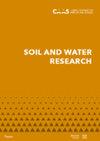Risk associated with occurrence of toxic elements in the environment surrounding landfills in An Giang Province, Vietnam
IF 1.7
4区 农林科学
Q4 SOIL SCIENCE
引用次数: 2
Abstract
The study aimed to evaluate the concentration of potentially toxic elements in the soil samples of landfill sites in An Giang province. Eighty-eight soil samples were collected from five landfills. The potentially toxic elements including Cu, Zn, Pb, Cd, and As were analysed and compared with the National technical regulations on the allowable limits of heavy metals in the soils. A cluster analysis was applied to identify the sampling sites with similar soil toxic elements properties. The ecological potential risk index was used to determine the risk of the landfills to the ecosystem. The results showed that four out of five potentially toxic elements were detected in the soil, and their concentration decreased in the order of Zn > Cu > Pb > As. Most of the potentially toxic element concentrations were within the allowable limits, except for Cu and As in some positions. The ecological potential risk index in unsanitary landfills was higher than that in a sanitary landfill; however, the level of risk was low. The occurrence of toxic elements in the soil around the landfills affects the ecosystems as well as human health. Therefore, it is necessary to prevent the effect of heavy metals in the surrounding environments.越南安江省垃圾填埋场周围环境中有毒元素发生的风险
本研究旨在评价安江省垃圾填埋场土壤样品中潜在有毒元素的浓度。在五个堆填区收集了88个土壤样本。对土壤中Cu、Zn、Pb、Cd、As等潜在有毒元素进行了分析,并与《国家土壤重金属允许限量技术规范》进行了比较。采用聚类分析方法确定了土壤有毒元素性质相似的采样点。采用生态潜在风险指数来确定垃圾填埋场对生态系统的风险。结果表明,土壤中检出了5种潜在有毒元素中的4种,其浓度依次为Zn > Cu > Pb > As。除Cu和As在部分位置外,大部分潜在有毒元素浓度均在允许范围内。不卫生填埋场的生态潜在风险指数高于卫生填埋场;然而,风险水平很低。垃圾填埋场周围土壤中有毒元素的出现不仅影响生态系统,也影响人类健康。因此,有必要防止周围环境中重金属的影响。
本文章由计算机程序翻译,如有差异,请以英文原文为准。
求助全文
约1分钟内获得全文
求助全文
来源期刊

Soil and Water Research
Water resources, Soil Science, Agriculture-WATER RESOURCES
CiteScore
4.60
自引率
0.00%
发文量
26
审稿时长
>12 weeks
期刊介绍:
An international peer-reviewed journal published under the auspices of the Czech Academy of Agricultural Sciences and financed by the Ministry of Agriculture of the Czech Republic. Published since 2006.
Thematic: original papers, short communications and critical reviews from all fields of science and engineering related to soil and water and their interactions in natural and man-modified landscapes, with a particular focus on agricultural land use. The fields encompassed include, but are not limited to, the basic and applied soil science, soil hydrology, irrigation and drainage of lands, hydrology, management and revitalisation of small water streams and small water reservoirs, including fishponds, soil erosion research and control, drought and flood control, wetland restoration and protection, surface and ground water protection in therms of their quantity and quality.
 求助内容:
求助内容: 应助结果提醒方式:
应助结果提醒方式:


